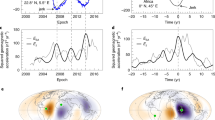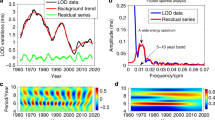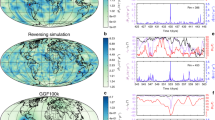Abstract
Geomagnetic jerks, which in the second half of the twentieth century occurred in 1969 (refs 1, 2), 1978 (refs 3, 4), 1991 (ref. 5) and 1999 (ref. 6), are abrupt changes in the second time-derivative (secular acceleration) of the Earth's magnetic field. Jerks separate periods of almost steady secular acceleration, so that the first time-derivative (secular variation) appears as a series of straight-line segments separated by geomagnetic jerks. The fact that they represent a reorganization of the secular variation implies that they are of internal origin (as has been established through spherical harmonic analysis7), and their short timescale implies that they are due to a change in the fluid flow at the surface of the Earth's core (as has also been established through mapping the time-varying flow at the core surface8). However, little is understood of their physical origin. Here we show that geomagnetic jerks can be explained by the combination of a steady flow and a simple time-varying, axisymmetric, equatorially symmetric, toroidal zonal flow. Such a flow is consistent with torsional oscillations in the Earth's core, which are simple oscillatory flows in the core that are expected on theoretical grounds9, and observed in both core flow models10 and numerical dynamo models11.
This is a preview of subscription content, access via your institution
Access options
Subscribe to this journal
Receive 51 print issues and online access
$199.00 per year
only $3.90 per issue
Buy this article
- Purchase on Springer Link
- Instant access to full article PDF
Prices may be subject to local taxes which are calculated during checkout



Similar content being viewed by others
References
Courtillot, V., Ducruix, J. & LeMouël, J.-L. Sur une accélération récente de la variation séculaire du champ magnétique terrestre. C. R. Acad. Sci. D 287, 1095–1098 (1978)
Malin, S., Hodder, B. & Barraclough, D. 75th Anniversay Volume of Ebro Observatory (ed. Cardus, J.) 239–256 (Roquetes, Tarragona, Spain, 1983)
Gavoret, J., Gilbert, D., Menvielle, M. & LeMouël, J.-L. Long-term variations of the external and internal components of the Earth's magnetic field. J. Geophys. Res. 91, 4787–4796 (1986)
Gubbins, D. & Tomlinson, L. Secular variation from monthly means from Apia and Amberley magnetic observatories. Geophys. J. R. Astron. Soc. 86, 603–616 (1986)
Macmillan, S. A geomagnetic jerk for the early 1990's. Earth Planet. Sci. Lett. 137, 189–192 (1996)
Mandea, M., Bellanger, E. & LeMouël, J.-L. A geomagnetic jerk for the end of the 20th century? Earth Planet. Sci. Lett. 183, 369–373 (2000)
Malin, S. & Hodder, B. Was the 1970 geomagnetic jerk of internal or external origin? Nature 296, 726–728 (1982)
Waddington, R., Gubbins, D. & Barber, N. Geomagnetic field analysis—V. Determing steady core-surface flows directly from geomagnetic observations. Geophys. J. Int. 122, 326–350 (1995)
Taylor, J. The magnetohydrodynamics of a rotating fluid and the Earth's dynamo problem. Proc. R. Soc. Lond. A 274, 274–283 (1963)
Zatman, S. & Bloxham, J. Torsional oscillations and the magnetic field within the Earth's core. Nature 388, 760–763 (1997)
Kuang, W. Force balances and convective state in the Earth's core. Phys. Earth Planet. Inter. 116, 65–79 (1999)
Courtillot, V. & LeMouël, J. Geomagnetic secular variation impulses. Nature 311, 709–716 (1984)
Roberts, P. H. & Scott, S. On the analysis of the secular variation, 1, A hydromagnetic constraint. Theory. J. Geomagn. Geoelectr. 17, 137–151 (1965)
Bloxham, J. The steady part of the secular variation of the Earth's magnetic field. J. Geophys. Res. 97, 19565–19579 (1992)
Bullard, E. C. & Gellman, H. Homogeneous dynamos and terrestrial magnetism. Phil. Trans. R. Soc. Lond. A 247, 213–278 (1954)
Davis, R. & Whaler, K. The 1969 geomagnetic impulse and spin-up of the Earth's liquid core. Phys. Earth Planet. Inter. 103, 181–194 (1997)
Jackson, A. Time-dependency of tangentially geostrophic core surface motions. Phys. Earth Planet. Inter. 103, 293–311 (1997)
Le Huy, M., Mandea, M., LeMouël, J.-L. & Pais, A. Time evolution of the fluid flow at the top of the core. Geomagnetic jerks. Earth Planets Space 52, 163–173 (2000)
Zatman, S. & Bloxham, J. The Core-Mantle Boundary Region (eds Gurnis, M., Wysession, M., Knittle, E. & Buffett, B.) 183–196 (AGU Monograph, American Geophysical Union, Washington DC, 1998)
Acknowledgements
This work was supported by NSF and NASA. The authors thank A. Jackson and S. Macmillan for providing observatory data.
Author information
Authors and Affiliations
Corresponding author
Ethics declarations
Competing interests
The authors declare that they have no competing financial interests.
Rights and permissions
About this article
Cite this article
Bloxham, J., Zatman, S. & Dumberry, M. The origin of geomagnetic jerks. Nature 420, 65–68 (2002). https://doi.org/10.1038/nature01134
Received:
Accepted:
Issue Date:
DOI: https://doi.org/10.1038/nature01134
This article is cited by
-
Core Eigenmodes and their Impact on the Earth’s Rotation
Surveys in Geophysics (2022)
-
Criteria of vibration control in delayed third-order critically damped Duffing oscillation
Archive of Applied Mechanics (2022)
-
Geomagnetic core field models and secular variation forecasts for the 13th International Geomagnetic Reference Field (IGRF-13)
Earth, Planets and Space (2020)
-
Intradecadal variations in length of day and their correspondence with geomagnetic jerks
Nature Communications (2020)
-
Recent progress in identification of the geomagnetic signature of 3D outer core flows
Acta Geodaetica et Geophysica (2020)
Comments
By submitting a comment you agree to abide by our Terms and Community Guidelines. If you find something abusive or that does not comply with our terms or guidelines please flag it as inappropriate.



